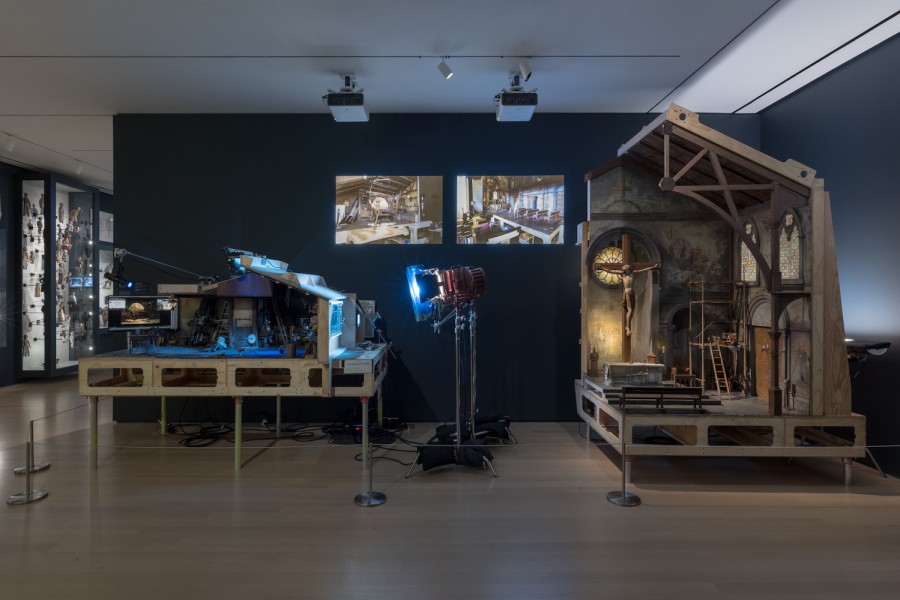‘Guillermo del Toro: Crafting Pinocchio,’ a look at the stop-motion behind Netflix’s new adaptation
Following the release of Guillermo del Toro’s “Pinocchio,” the Museum of Modern Art has staged an exhibition composed of the film’s sets, puppets and other behind-the-scenes looks.
The Museum of Modern Art, New York. Photo by Emile Askey
Guillermo del Toro: Crafting Pinocchio, The Museum of Modern Art, New York, Dec. 11, 2022–April 15, 2023. © 2022 The Museum of Modern Art. Photo by Emile Askey. (Courtesy of the Museum of Modern Art)
December 14, 2022
From Dec. 11 through April 15, the Museum of Modern Art will be displaying “Guillermo del Toro: Crafting Pinocchio,” a remarkable exhibition detailing the behind-the-scenes craft of the new stop-motion-animated film, “Guillermo del Toro’s Pinocchio,” which is currently streaming on Netflix. The small yet enlightening exhibition includes production art, hand-crafted sets, puppets and inside looks into the process of making stop-motion animation films.
Beginning with early fables and literary adaptations of Carlo Collodi’s original novel, “The Adventures of Pinocchio,” viewers will be introduced to the various iterations of Pinocchios made for Del Toro’s newest film. Each model was used for separate scenes that were filmed simultaneously.
The film, created by hundreds of animators and technicians over the span of nearly 1,000 days, was handmade and manually animated in Portland, Oregon; Guadalajara, Mexico; and Altrincham, England. Filming took place in different warehouses, where people collaborated to bring Del Toro’s vision to life.
[Read more: Stop-motion animation in ‘Guillermo del Toro’s Pinocchio’ emotionally captures life’s transience]
Stop-motion animation involves moving figures slightly over a period of time, capturing each frame in order to create movement once they are compiled. The exhibition — through its video installations — shows how each subject is moved frame-by-frame in order to create a sense of flow among the puppets, as if they had come to life. These behind-the-scenes videos give viewers insight into how Pinocchio, Geppetto, Cricket and the many other unique characters in Del Toro’s film seamlessly and beautifully come to life.
Displayed sets from the film include Pinocchio’s lively village, a remarkably designed interior of Geppetto’s house and a fascist Italian youth camp, reasserting the film’s political setting of Mussolini’s Italy. The working set of an Italian village from the beginning of the film consists of authentically crafted road bumps, litter and imperfect architecture — all of which are immensely detailed and complex designs for an animated feature.
Geppetto’s home is possibly the most detailed and artistically expressive set in the entire film, as it is filled to the brim with remarkable texture, visual nuance, and a sense of depth and tactility. The exhibition also includes pre-production illustrations of characters and early designs of models. The production design and stagecraft are exquisitely displayed in “Crafting Pinocchio,” highlighting the authenticity and intimacy present in the film’s incredibly lively and layered environments, settings and characters.
“Crafting Pinocchio” highlights animation as a seminal art rather than a mere genre. Through hand-carved models and technically astounding set design, talented artists stress the importance of stop-motion animation and hand-crafted art.
The exhibition not only elevates the artistic merits of Del Toro’s film, but also demonstrates the intrinsic value of practicality in an age of overdone computer generation and artificial storytelling. Tangibility — the ability to embrace a work of art’s realism — never overstays its welcome in “Crafting Pinocchio.” In fact, it reinforces the potential for art to be emotionally and artistically resonant with the audience.
Contact Yezen Saadah at [email protected].

























































































































































